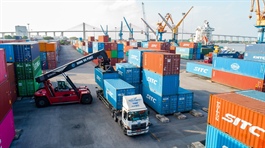Businesses baulk at seaport payment inconsistencies
Businesses baulk at seaport payment inconsistencies
Many businesses in the south are suffering from added financial burdens, with newly-introduced seaport fees differing wildly among localities and affecting their activities.

Ho Chi Minh City started to apply a new fee for the use of the infrastructure and public utility services at border gates and seaports in the city from April 1. According to Ho Chi Minh City Department of Transport, in the first 10 days it reported 59,000 declarations with a total collected fee volume valued at $3.86 million.
While businesses are complying with the new regulation, many have called the rates inappropriate, especially in terms of the difference between the city and neighbouring localities.
Le Viet Anh, secretary of the Vietnam Pepper Association (VPA), told VIR, “The association’s members have reflected that they feel the difference in making declarations of cargo in Ho Chi Minh City and other localities is unreasonable.”
According to the regulations, for imported and exported goods declared in Ho Chi Minh City, the fee is now VND250,000 ($10.85) per 20ft container and VND500,000 ($21.70) per 40ft container, while fees for liquid and bulk cargo would be VND16,000 (70 US cents) per tonne. However, the fees outside Ho Chi Minh City are all doubled in price (see box).
“This difference means businesses are flocking to Ho Chi Minh City to make a declaration to save costs, which will cause jams and overload for customs clearance at the city’s seaports,” Anh said. “Meanwhile, localities will lose a part of the import-export tax. More congestions and delays in customs clearance might therefore happen at seaports in Ho Chi Minh City.”
On April 4, private economic development research group IV Board, established by the government’s Advisory Council for Administrative Procedure Reform, reported to the prime minister various problems that have arisen during the fee collection process.
“The difference goes against the prevailing fee and customs laws, which is an act of discrimination and makes life challenging for businesses in the city’s neighbouring provinces,” the IV Board noted in a document.
The IV Board also proposed to halt the collection of fees for goods temporarily imported for re-export, goods deposited in bonded warehouses, and transit and transshipment goods, which currently have the highest fees.
Business associations previously asked the Vietnamese government to scrap such seaport fees due to the concern that the regulation will raise the financial burden on businesses, leading to possible competitiveness reduction.
Phan Minh Thong, chairman and general director of agricultural product exporter Phuc Sinh Corporation, told VIR, “The company exports an average of 6,000 containers of goods per year, thus it has to spend an additional $65,200 for seaport infrastructure fees, which piles pressure on exporters and importers amid the rising costs of logistics services.”
According to the Vietnam Association of Seafood Exporters and Producers, there are seven toll stations from the south-central province of Khanh Hoa to Cat Lai Port in Ho Chi Minh City with a fee of $15.50 per trip. A seafood exporter and producer transporting 3,000 containers has to spend an average of $326,000 on these tolls per year.
Since the seaport fee collection policy came into effect, a medium-sized seaport enterprise is estimated to shoulder an additional $240,000 per year for this fee, while larger groups could be hit by as much as $610,000 per year.
The Vietnam Seaport Association’s statistics show that in 2021, the total volume of container cargo going through seaports in Ho Chi Minh City was just under eight million TEUs, accounting for about 43 per cent of the whole country’s cargo, excluding liquid and bulk goods. In addition, over 70 per cent of import-export seafood volume for the whole country goes through the city’s seaport system.



















